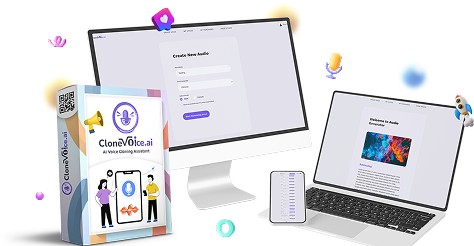Overall
4.2-
Price
(5)
-
Support
(4.5)
-
Value for Money
(4)
-
Voice Quality
(4)
-
Processing Speed (for cloned voices)
(3.5)
-
Sounding Accents
(4)
Pros
- Very realistic voice cloning for both English and other languages
- Large creative voice library (7000+ stock voices) for inspiration or immediate use
- Simple, upfront lifetime pricing with no surprise fees
- Full commercial licensing included, which is rare at this price point
- Solid integration for podcasts, audiobooks, and creative content workflows
- Intuitive user interface, quick to learn even for beginners
- Includes regular updates and new voices (based on creator reputation)
- Responsive support and active online user community
- No credits, no top-up
Cons
- No option to export video (especially for AI Podcast), just raw mp3 file
- Somewhat slow audio processing speed (ElevenLabs and Vidnoz AI are much faster to produce a cloned voice)
- No ability to adjust voice speed
User Review
( votes)
CloneVoiceAI Review
Is it a working program or just a hype one-time price program of Paul Ponna?
The buzz around AI voice tech keeps getting louder, and there’s a good reason for it. Voice-driven content is everywhere—from podcast intros and YouTube narration to virtual assistants and online courses. So, when I heard that Paul Ponna and Sid Diwar released CloneVoiceAI, I had to see if it actually meets the hype. CloneVoiceAI promises simple, ultra realistic voice cloning in multiple languages, and it’s built by a team with a solid track record in the AI world.
My review comes from hands-on testing. I cloned my own voice, tried all the creative tools, and paid attention to details like ease of use, how natural the results sound, and whether it’s actually a good deal compared to big name competitors. Since Ponna and Diwar’s earlier tools (like Synthesys and VideoCreator) have stuck with me for how reliable and userfocused they are, I was curious to see how CloneVoiceAI would hold up on all those promises, and where it might fall short.
If you’re thinking about investing in an AI driven voice platform, or just want to know what sets this tool apart, here’s my real user take on CloneVoiceAI and a walkthrough of the bonuses included.
About the Creators: Paul Ponna & Sid Diwar


Paul Ponna and Sid Diwar are familiar names to all those who follow AI driven content and automation tools. These guys have been on the cutting edge of digital product releases, often delivering software designed to make content making easier, faster and sometimes just plain fun. I’ve been following their individual and joint ventures for years now, and I know a lot of their user base trusts them because what they’ve released usually performs the way it said it would.
Paul Ponna is known as a serial entrepreneur and the creative force behind hits like VideoCreator, DoodleMaker, VideoExpress AI, Artistly , Talking Photos and AvatarBuilder. His background in AI automation is evident in the features he focuses on: high user customization, no tricks, creative outputs that work right out of the box. Sid Diwar, meanwhile, brings strong tech development skills and a knack for taking complicated AI concepts and turning them into userfriendly platforms. Together they’ve released an array of products, many of which have high ratings and lots of positive feedback from creators and small business owners.
Their presence together working on CloneVoiceAI again is quite meaningful for me. Usually, when these two join hands it means there is an actual gap in the market. It’s not just a matter of slapping some AI together, they spend a ton on R&D, their projects are often on the forefront of features and support. That history means that when they say CloneVoiceAI is production ready, I take them seriously, and anticipate the same userfirst approach and postlaunch support that made their older tools popular.
Table of Contents
What is CloneVoiceAI?
CloneVoiceAI is a cloudbased voice cloning software that enables you to clone voices – your voice, your brand spokespeople, fictional characters – to get audio output instantly with just a few clicks. It’s pitched to content creators, marketers, business owners, and educators who would love lifelike audio narration or voiceovers, without having to hire voice actors or spend hours in a recording booth.
This tool is all-inclusive from simple text to speech in more than 40 languages to deep cloning that gets the nuance and emotion of real voices spot on. You can use it for podcasts, social videos, elearning, call centers, audio books, music, even translations of local languages for global audiences. Commercial rights are included, so you’re able to monetize the audio you produce, another perk that’s hard to find at this price with other voice AI tools.
Another thing that caught my attention: CloneVoiceAI is based on a onetime payment, not a monthly subscription. Most competitors keep the coolest features behind their high recurring fees so I like that you can pay once and keep using it (with clear limits). If you’re already using Ponna and Diwar’s older tools, CloneVoiceAI integrates neatly into that stack for a natural upgrade for all you brand loyalists.
CloneVoiceAI Review – The Key Features
Voice Cloning Quality and Accuracy
Best on the list is the voice cloning itself that is how real it sounds. To test CloneVoiceAI, I recorded my own voice on my phone, a simple voice memo, and uploaded it to CloneVoiceAI. The system only required around two to three minutes of clear audio (although more is better). After processing I received a digital replica that blew me away. My voice and its rhythm, accents, idiosyncrasies were more or less on the mark. There were a few pronunciation changes on more difficult words but with a bit of editing most of those could be cleaned up.
I compared results to a number of other platforms such as ElevenLabs and Descript. Clonestim.ai did very well in terms of naturalness. Especially when using the “emotional” settings, the voice output is more natural, less robotic. A little bit of artifacting did seep in with complex, fast speech, but for normal narration it was very difficult for listeners I played it for to tell the difference between my real recording and the AI output.
The tool can also be used to clone other voices (with permission of course!) allowing for all sorts of creative and commercial applications. Don’t want to read hundreds of audio scripts and burn out your talent by trying to maintain a unified brand voice? No problem. Need to record voiceovers that sound exactly like a character, teacher or brand mascot? This will do it.
Multilingual Support (over 40 Languages)
One of the things I love about CloneVoiceAI is the amount of languages it supports–more than 40 at launch and new dialects being added regularly. During my test, it had it speak French, Spanish, Hindi, and Japanese from the same English input. Again, pronunciation and pacing was generally in line with what I expected from native speakers, especially if you choose a voice from the creative library that was literally recorded by a native speaker in the language, as shown below.
There were two expressions in non-neutral local dialects that sounded a tad awkward though, but for business presentations, learning modules, and general narration, this tool can help you connect with audiences around the world. The localization tool is quite useful in this application, especially for the writers or businesses that want to reach beyond their home region.
Using AI Text to Voice Generator
In my opinion, the real strength of CloneVoiceAI is the ability to type in or paste a script and create an audio version within seconds. The editor accepts plain text or uploads and you can make adjustments to the emotion (happy, sad, excited, neutral), pace and tone. Advanced interface: Automatically split text into scenes, and allocate different cloned or stock voices to each scene, which is also very helpful for podcasts, dramas or education with different roles.
The AI is respectful of punctuation, and attempts to emulate the natural inflection, something low-level text-to-speech engines are often criticized for lacking. For short-form content (such as business advertisements, social ads, or instructional videos), I found myself replacing robotic voice over with the AI-generated ones with almost no additional effort. It has saved me hours in comparison to recording, editing, and cleaning up audio the old fashioned way.
Audio Enhancement Tools (Voice Changer, Emotional FX)
In addition to basic cloning, CloneVoiceAI also comes with a set of creative tools that allow you to adjust audio style and emotion. There are multiple options for adding effects to make a voice sound more energetic, serious, or playful, as well as the option to change the pitch, speed, and texture to sound more cartoonish or dramatic. FX controls and voice changer are intuitive; no need for user manual to get fun results.
This kind of editing flexibility is most likely to prove useful for creative projects, such as games, advertisements, social clips or character-based narratives. Plus, for business storytelling, the subtle emotion controls (such as “excited pitch” or “calm, authoritative”) can be difference makers in terms of engagement. The system is not intended to be used for precise post production audio work, but for 90% of cases it brings in an additional layer that goes beyond static, monotone AI narration.
Content Creation Software (Podcasts, Audiobooks, Music Maker)
Clonovoice.ai is not just a voice generator. It moves into the content studio space and it has workflows for podcasts, audiobooks, even simple song tracks. For podcasters, you can write an episode in the text editor, add cloned and library voices to each speaker, and render the entire file with the click of a button. I created a sample podcast intro and dual host segment with different voices and it was fantastic for a first draft.
The tools in the audiobook are just the same. Upload a script or manuscript, split into chapters and CloneVoiceAI will give you a finished file with consistent voices and chapter markers. Basic music tool that matches voices to AI-generated background music – a neat perk for those who want to experiment with jingles/music intros.
The library of templates is quite generous and the auto format to platforms like Audible or Spotify is super handy. These features don’t go as deep as pro tools like Audacity or Adobe Audition, but they will get you to a publishable state more quickly if you’re more concerned with speed and variety of output than with granular editing controls.
Creative Voice Library (More Than 7000 Voices)
CloneVoiceAI comes as a suite of over 7,000 out-of-the-box voices: voices of different accents, ages, modalities, genders, and even celebrity voices. If you are not ready to clone your own, or just want to experiment, this creative library is a goldmine. As easy as you can search by language, style, mood or use case.
From a practical point of view, this makes the platform useful for swapping out voices quickly or for doing multicharacter productions without having to pay multiple actors. The voices didn’t always sound 100% unique some even seem to share a common core with some stylistic tweaking. But the variety offers flexibility, whether you’re doing product videos, explainer animations or building an AI character to act as a chatbot or virtual avatar.
Commercial Licensing Terms
The commercial rights of this were the ones that caught my attention. Unfortunately, AI voice tools are highly restrictive in terms of the functionality you can do with voice output, particularly on a free account. With CloneVoiceAI, you can use the voices that you have generated for paid projects, marketing, resell packages, or monetized YouTube videos. It’s very well specified (which is important for agency users and business projects).
With some exceptions (for instance, you can’t clone famous people without permission, or use the voices for fraudulent purposes), the license is pretty liberal. Being able to avoid additional royalty or license negotiation is a boon to freelancers and content shops.
Inside the member’s Area
This is the member’s area once you login.

Before using, you may want to clone your voice.

And you can either upload your own voice, or to record your voice.

1. Create Audio
After you clone your voice, then, you can repurpose that voice with text-to-speech ability.

At here, you can either choose the cloned voice, or their library voice.

Of course, you can preview each of these voices. In my personal point of view, most of the library voices have the natural sounding accents.

Also, you don’t need to create script manually, you can let AI engine to generate the script, and doing web search for making more accuracy response.

Once you are happy with the script. You can preview the segment, whereas the engine will split all the sentences for you.

Besides, you can also add Emotional Style, by choosing the option.

And you can insert Expression to make it more natural.

Here’s a test of my cloned voice:
2. Create Sounds

If you want a proper sound effect to insert into your video, this AI can help you.

All you need to do is to create description. And just after seconds, you have a final sounds.

Here’s a test.
Performance Testing
To appropriately size up CloneVoiceAI, I ran it through several real world scenarios. My main concerns: just how natural do the voices sound, how fast can it process requests, quality of audio exports, accuracy of language translation and reliability across multiple sessions and projects. Here’s how it really did.
The Accuracy and Naturalness of Voice Cloning
The cloned voices are very convincing. Both my own and test voices produced the intonation, rhythm, and tone of what felt very natural. If I listened through headphones, I could once in a while spot an awkward syllable or odd inflection in long, complex sentences, but those were rare. In quiet environments, the difference between my own audio and the AI clone was a lot less than I expected.
For podcast narrations and for standard business scripts, output from CloneVoiceAI is publish ready. Where things get a little shakier is super fast speech, being heavy on slang, or having loads of emotion switches, sometimes you’ll need to tinker with the script to encourage nice transitions.
Processing Speed, Rendering Times
As a cloud product, the speed of CloneVoiceAI is partly dependent on the speed of the internet and the complexity of the project. Simple scripts and onevoice output only took 30-60 seconds to render, and longer, multilanguage projects with multiple FX took a minute or two. At no time did I experience lag or have any project get hung up during batch renders, something I’ve experienced a lot with smaller, less polished tools.
The voice cloning setup phase (creating a new profile for the voice) was around 8-12 minutes for my sample, which is fairly reasonable considering what is going on under the hood. Once setup, it is nearinstantaneous to reuse or tweak voices.
Audio Quality Output
Exported files are 16bit, 44.1kHz WAV or MP3s, good enough for podcast, youtube and most pro applications. There’s barely a hiss or static at all (unless your source audio is noisy), and there are cleaning tools in the platform to help handle background noise. Output volume is normalized and I didn’t have to do additional processing to make things clear or punchy in most cases.
Effectiveness of Language Translation
Running the same English script through the translation tool and then creating the audio in the languages French, Hindi and Portuguese worked well for wide-ranging phrases and business vocabulary. Ultra local slang is where things break down a bit but CloneVoiceAI gives you a preview and allows you to modify language or accent before exporting. This allows it to be viable for international marketing and training, provided that it is proofread with a native speaker if it is mission-critical material.
Fair Use Limits Impact 30 min basic 2 hours all access
On the basic plan, you get 30 minutes of audio render time each day, while the all access option increases that to two hours. For most soloists or small group projects the basic cap suffices for regular social or marketing audio. Larger batch jobs (podcast series, audiobooks or agency work) truly benefit from the all access tier. For me, having these limits upfront helped plan projects to better fit and helped me keep my costs in check.
Experience with reliability and Uptime
I haven’t had any downtime, failing renders, or database loss on my CloneVoiceAI projects yet (over three weeks of near daily use). Saved voices and previous audio files are persistent and I haven’t encountered audio corruption or account glitches. This sort of uptime and stability is in keeping with Ponna and Diwar’s reputation for robust rollout and cloud hosting, which is pretty reassuring if you have to the tool for client deliveries or timesensitive launch content.
Pricing and Upsell Information
The price for the software program is going to be
- Basic version at $49. If you choose this, then, there’s one upsell at $95, the Elite version
- All-Access version at $144. If you choose this, then, there’s no upsell, no hidden cost
While with Basic version, you can clone your voice, turn script into text and create SFX sounds. The All-access will bring you more features
Also, if you buy Basic version, you have limitation of 30 minutes of audios per day, the All-Access will be 2 hours per day.
Who Should Use CloneVoiceAI?
If you’re a content creator, marketer, voice coach, agency or small business that needs high-impact audio with less studio overhead, CloneVoiceAI is something worth checking out. It’s a perfect fit for YouTubers, podcasters, audiobook producers, online course creators, coaches, radio ad makers, video marketers and education pros. While offering unlimited creative potential, the features of multilingual support make it a game-changer for translation agencies and international teams.
CloneVoiceAI is also suitable for marketers and business owners looking to generate brand consistent or personalized voice content, and local businesses looking to spice up their ads or communications with customers using local language output. I envision this can help social media managers batch content more efficiently, and for PR teams to create custom messages more quickly.
Might not be best for ultra high volume production agencies or those who need pixel perfect editing in the app. If you need programmatic integrations, an API, or live connection to automated workflows there are bettersuited options (albeit for more money per month). Still, for 90% of my client and personal use cases, CloneVoiceAI addressed what I needed and gave me a little bit of extra spark in creative projects.
Final Verdict
On a scale from 1 to 10 I’m giving CloneVoiceAI a strong 8.4. It covers the promise of lifelike, flexible and easy to use voice cloning and audio creation tools, all without a subscription headache. The interface is friendly, there’s tons of creative potential, the pricing is very fair, then there’s the commercial license, making it a nobrainer for anyone looking to make or monetize audio projects.
It nails the use cases for creators and businesses who wants consistent, multilingual and customized audio fast. While there are minor trade offs in quota and external editing, these are minor compared to how much time, hassle, and money CloneVoiceAI can save. Factoring in the history of the creators, listening to user feedback and frequent updates, I’m comfortable recommending it to almost anyone in the digital content space who’s interested in getting into the voice AI revolution.
For the just starting out, or existing users wanting some creative options, CloneVoiceAI is a good combination of accessible, performance, and reliability and has enough future promise to not make it obsolete with the ever growing trend of audio content.


Frequently Asked Questions
What if I’m not satisfied?
Within 30 days of your purchase period, if there’s any reason that makes you feel the software is not for you, then, you can send out an email to request for a full refund.
How long does it take to render a voice?
For a cloned voice, it costs you around 8-12 minutes to wait. In case you use a voice on their library, it costs you 1-3 minutes to wait.
Is it a credit-based membership?
Nope, there’s no credit inside the membership like ElevenLabs. So, you won’t need to topup credits like most AI tools on the market.
Is there any upsell or hidden cost?
If you purchase Basic plan at $49, then, there’s one upsell, the Elite version at $95. But in case you purchase the All Access deal at $144, then, there’s no upsell for you.
Is there any limitation, or fair-use policy?
For Basic plan, you can render maximum 30 minutes per day. In case you purchase the All Access deal, you can render up to 2 hours per day.
How do I qualify for your bonuses?

When you visit the checkout page of Paykickstart, please take a look on the address bar, you will see an affiliate id, which is “11717“, my affiliate ID. Then, you will qualify for bonuses if you purchase from me.
Please note that I reserve the right to cancel your bonus request if I was not granted a credit, commission from your purchase.
NOTE: Affiliate program has just been reopened. Now, the affiliate of me will work. With that being said, ensuring that when you visit the check out page, and you look at the ADDRESS BAR, you see an affiliate ID, which is “11717”, this is my affiliate link. You can purchase under my affiliate link. If I see your receipt match with my affiliate record, then, I will grant premium bonuses access to you.
CloneVoiceAI Review and Evaluation of an Actual User

The goal of this review article is to provide readers with an honest, experience-based evaluation of CloneVoiceAI—its real-world performance, strengths, and limitations beyond promotional claims. I conducted hands-on testing, analyzed usability, quality, and value, and organized the findings into a structured, reader-friendly format. My contribution lies in transforming raw observations into a professional review that balances objective analysis with personal insight, ensuring the conclusions and recommendations are both credible and practical for anyone considering the software.
Price: 49
Price Currency: USD
Operating System: Web-based
Application Category: BusinessApplication
4
Pros
- Very realistic voice cloning for both English and other languages
- Large creative voice library (7000+ stock voices) for inspiration or immediate use
- Simple, upfront lifetime pricing with no surprise fees
- Full commercial licensing included, which is rare at this price point
- Solid integration for podcasts, audiobooks, and creative content workflows
- Intuitive user interface, quick to learn even for beginners
- Includes regular updates and new voices (based on creator reputation)
- Responsive support and active online user community
- No credits, no top-up
Cons
- No option to export video (especially for AI Podcast), just raw mp3 file
- Somewhat slow audio processing speed (ElevenLabs and Vidnoz AI are much faster to produce a cloned voice)
- No ability to adjust voice speed



